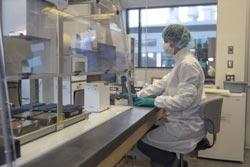Resourceful Microbes Reign in World’s Oceans

PHOTO: Research underway in the Bigelow Single Cell Genomics Center. Photo by Dennis Griggs.<br>
A research team led by Bigelow Laboratory for Ocean Sciences has discovered that marine microbes are adapted to very narrow and specialized niches in their environment. This may explain why so few of these microbes—usually less than 1%—can be grown for study in the laboratory.
By utilizing new genetic tools, the researchers’ new ability to read and interpret genetic information from the remaining 99% will be pivotal in detecting and mitigating the impact of human activities in the ocean. Funded by the National Science Foundation, the study was published in the Proceedings of the National Academy of Sciences of the United States of America this week.
The cutting-edge technology that proved critical to the research, and was implemented on a large scale for the first time, is called single cell genomics.
“While other tools are available to analyze genes in uncultured microbes, they seldom tell us how these genes fit together and what microbes they come from,” said Ramunas Stepanauskas, the study’s senior author and director of the Bigelow Single Cell Genomics Center (SCGC). “By developing and applying high-throughput single cell genomics, we obtained the first near-complete genomic blueprints of many microbial types that dominate marine ecosystems but used to be inaccessible to scientific investigation.”
“We found that natural bacterioplankton are devoid of ‘genomic pork,’ such as gene duplications and noncoding nucleotides, and utilize more diverse energy sources than previously thought. This research approach opens a new chapter in the exploration of microbial life in the oceans and in other environments on our planet.”
“We found that genomic streamlining is the rule rather than exception among marine bacterioplankton, an important biological feature that is poorly represented in existing microbial cultures,” said Brandon Swan, lead author and postdoctoral researcher in the SCGC. “We also found that marine microbes are effectively dispersed around the globe, but they stay within their temperature ‘comfort zones.’ Bacteria that thrive in the frigid Gulf of Maine don’t show up near Hawaii. However, as long as the temperature is right, the same types are found anywhere in the world, whether on the coast of British Columbia, Northern Europe, or Tasmania.”
“Thanks to single cell genomics and other technological advances, we now have a much more accurate understanding of the biological diversity and processes taking place in the ocean,” said Tanja Woyke, a key co-author from the Department of Energy Joint Genome Institute. “The amount of adaptations and biochemical innovation that have accumulated in marine microorganisms over billions of years of evolution is astounding—a glass of seawater encodes more genetic information than a desktop computer can hold. This information represents a largely untapped source of novel natural products and bioenergy solutions, both essential for human well-being.”
Bigelow Laboratory for Ocean Sciences is an independent, non-profit center for global ocean research, ocean science education, and technology transfer. The Laboratory conducts research ranging from microbial oceanography — examining the biology in the world’s oceans at the molecular level — to the large-scale processes that drive ocean ecosystems and global environmental conditions.
EDITOR’S NOTE: Dr. Stepanauskas may be contacted at 207-315-2567, ext. 308, or at rstepanauskas@bigelow.org.
Contact: Tatiana Brailovskaya, Director of Communications, Bigelow Laboratory for Ocean Sciences, (207) 315-2567, ext. 103; tbrailovskaya@bigelow.org
Media Contact
More Information:
http://www.bigelow.orgAll latest news from the category: Life Sciences and Chemistry
Articles and reports from the Life Sciences and chemistry area deal with applied and basic research into modern biology, chemistry and human medicine.
Valuable information can be found on a range of life sciences fields including bacteriology, biochemistry, bionics, bioinformatics, biophysics, biotechnology, genetics, geobotany, human biology, marine biology, microbiology, molecular biology, cellular biology, zoology, bioinorganic chemistry, microchemistry and environmental chemistry.
Newest articles

Superradiant atoms could push the boundaries of how precisely time can be measured
Superradiant atoms can help us measure time more precisely than ever. In a new study, researchers from the University of Copenhagen present a new method for measuring the time interval,…

Ion thermoelectric conversion devices for near room temperature
The electrode sheet of the thermoelectric device consists of ionic hydrogel, which is sandwiched between the electrodes to form, and the Prussian blue on the electrode undergoes a redox reaction…

Zap Energy achieves 37-million-degree temperatures in a compact device
New publication reports record electron temperatures for a small-scale, sheared-flow-stabilized Z-pinch fusion device. In the nine decades since humans first produced fusion reactions, only a few fusion technologies have demonstrated…





















